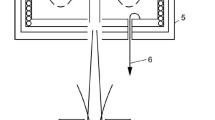The influence of harmonic interference on the metrological characteristics of the output signal of a passive hydrogen frequency standard is analyzed. It is shown that the additional signals in the control circuit generated by the interference lead to the appearance of a frequency shift or parasitic modulation of the frequency of the standard. Results of an experimental investigation of interference suppression of passive hydrogen frequency standards are presented and methods of increasing interference suppression are also considered. The results obtained confirm a theoretical analysis.




Similar content being viewed by others
References
Y. Xie, P. Chen, T. Shuai, et al., “Characteristics of space mini passive hydrogen maser in Shanghai Astronomical Observatory,” in: Proc. Frequency and Time Forum and IEEE Intern. Frequency Control Symposium, Besancon, France (2017), pp. 607–611.
V. I. Vasil’ev and S. A. Kozlov, “Fine adjustment of the parameters of a passive hydrogen frequency standard and the time it takes to improve the frequency stability of the output signal,” in: Metrology of Time and Space: Proc. 7th Int. Symp., VNIIFTRI, Mendeleevo (2014), pp. 70–75.
E. A. Kolosovkskii, Signal Reception and Processing Instruments, Goryachaya Liniya-Telekom, Moscow (2012).
V. I. Vasil’ev, “An investigation of the limiting short-term frequency instability of the output signal of a passive hydrogen frequency standard,” Izmer. Tekhn., No. 9, 25–29 (2016).
V. I. Vasil’ev and G. P. Pashev, “Analysis of the frequency instability of the signal of a group of highly stable generators,” Izmer. Tekhn., No. 8, 43–45 (2017).
A. P. Narezhniy and V. N. Chinkov, “An investigation of the interaction regimes of precision frequency measures with nearly identical frequencies,” Aviats.-Kosm. Tekhn. Tekhnol., No. 5, Iss. 21, 52–56 (2005).
V. A. Logachev, “An investigation of the stability of a passive hydrogen frequency standard,” Tekhn. Sredstv Svyazi. Ser. RIT, Iss. 1, 30–36 (1986).
V. D. Gitel’son, “Determination of the error of synchronous detectors,” Izmer. Tekhn., No. 10, 65–66 (1977).
T. Williams, Electromagnetic Compatibility for Product Designers [Russian translation], Izd. Dom Tekhnologiya, Moscow (2003).
J. Barns, Electronic Design: Methods of Combating Interference [Russian translation], Mir, Moscow (1990).
GOST 30804.4.3–2013, Compatibility of Technical Electromagnetic Instruments. Resistance to the Radio-Frequency Electromagnetic Field. Requirements and Testing Methods.
Yu. D. Belenov, V. I. Vasil’ev, S. A. Kozlov, and V. A. Logachev, “Quantum hydrogen frequency standards and standard complexes based on such frequency standards,” in: Fundamental and Applied Coordinate-Time and Navigation Support: Proc. All-Rus. Conf., IPA RAN, St. Petersburg (2011), pp. 47–49.
Author information
Authors and Affiliations
Corresponding author
Additional information
Translated from Izmeritel’naya Tekhnika, No. 1, pp. 39–43, January, 2019.
Rights and permissions
About this article
Cite this article
Vasil’ev, V.I. Interference Suppression of Passive Hydrogen Frequency Standards. Meas Tech 62, 47–53 (2019). https://doi.org/10.1007/s11018-019-01584-3
Received:
Published:
Issue Date:
DOI: https://doi.org/10.1007/s11018-019-01584-3




